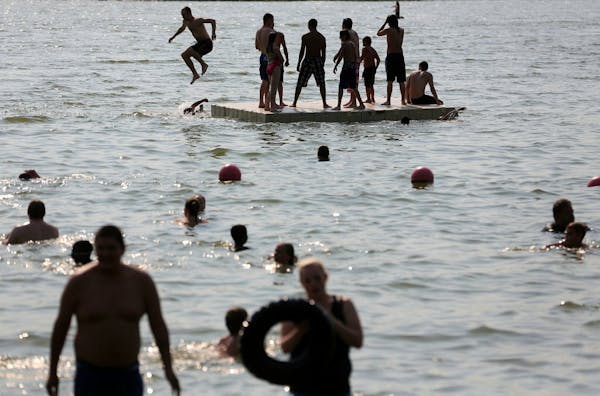Southern Minnesotans switched emphatically from heat to air conditioning Tuesday as triple-digit temperatures arrived where snowplows were busy only two weeks ago.
St. James hit 102 — the second-earliest such occurrence in Minnesota state records — while Albert Lea, which got socked with nearly a foot of snow May 2, and Fairmont both tasted 100. The Twin Cities reached 98, breaking an 81-year-old record for the date.
At 2 p.m., when St. James was baking at 102 and Fairmont at 100, the temperature at the Duluth Harbor, with a breeze blowing off Lake Superior, was 45.
The heat, while extreme, was "very welcome," in the words of Bob Wallace, president of the Fairmont Chamber of Commerce. After a long, tenacious winter that left farmers' fields frozen and then wet in early May, it will accelerate plowing, planting and plant growth, he said.
"I think everybody is loving it," Wallace said. "The air-conditioning people are going to be busy as can be now."
The heat may not have been as oppressive as it could have been. Assistant state climatologist Pete Boulay said extremely low humidities — 7 percent at St. James — resulted in a "feels like" reading of 95 when the temperature was 102. Such low humidity is not uncommon in spring before plants start pulling moisture out of the ground, Boulay noted. Very cold lake water cooled air close to lakes, he added. The ground was cool as well, a legacy of the lingering winter.
The 98-degree reading in the Twin Cities was the highest temperature so early in the season for any year on record. The state record for May is 112, set in Maple Plain on May 31, 1934. The Twin Cities' official May record is 106, set on the same date.
Elsewhere, planes and helicopters were helping fight several wildfires, including a 4,900-acre grass fire near Red Lake, and some smaller blazes near Menahga and Virginia. High winds, along with the heat and low humidity, prompted the National Weather Service to post a wildfire alert through Tuesday across most of Minnesota and the Dakotas. Winds across northern and western Minnesota blew steadily at more than 30 miles per hour, with gusts above 40 mph.
With lakes across northern Minnesota having lost their ice only in recent days, aircraft have been able to find enough water to scoop and drop on fires, said Jean Goad, spokeswoman for the Interagency Fire Center.
Conditions more seasonable for mid-May settle in the rest of the week in the Twin Cities, with highs in the mid-70s and the chance of rain growing more likely as the week rolls on. High temperatures may drop below 60 again early next week.
Staff writer Paul Walsh contributed to this report.
Bill McAuliffe • 612-673-7646
8 months in jail for Blaine man who caused 120-mph crash hours after he was caught speeding

Daughter sues St. Paul, two officers in Yia Xiong's killing

